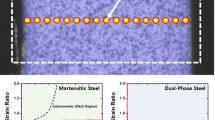We plot the conditional and true stress-strain diagrams for 65G steel according to the standard procedure and by the method of digital image correlation. It is shown that the accumulated results are in good agreement. It is established that the local strains measured by the method of digital image correlation on small measurement bases can be much higher than the ultimate true elongation of the material. We also propose a criterion for choosing the optimal base of strain measurements from the viewpoint of construction of stress-strain diagrams.





Similar content being viewed by others
References
Ya. B. Fridman, Mechanical Properties of Metals [in Russian], Part 1: Deformation and Fracture, Mashinostroenie, Moscow (1974).
M. L. Bernshtein and V. A. Zaimovskii, Structure and Mechanical Properties of Metals [in Russian], Metallurgiya, Moscow 1970).
GOST 1497-84/ST SÉV 471-77. Metals. Methods of Tensile Tests [in Russian], Izd. Standartov, Moscow (1985).
G. S. Pisarenko and V. A. Strizhalo, Experimental Methods in the Mechanics of Deformed Solid Bodies [in Russian], Naukova Dumka, Kiev (1986).
GOST 11701-84/ST SÉV 471-77. Metals. Methods for Tensile Testing of Light Sheets and Bands [in Russian], Izd. Standartov, Moscow (1985).
T. Chu, W. Ranson, and M. Sutton, “Applications of digital-image-correlation techniques to experimental mechanics,” Exper. Mech., 25, No. 3, 232–244 (1985).
M. A. Sutton, M. Cheng, W. H Peters, et al., “Application of an optimized digital correlation method to planar deformation analysis,” Image Vision Comput., 4, No. 3, 143–150 (1986).
B. Pan, K. M. Qian, H. M. Xie, and A. Asundi, “Two-dimensional digital image correlation for the in-plane displacements and strain measurements: a survey,” Measurement Sci. & Technol., 20, No. 6, 062001–062007 (2009).
VIC-2D Image Analysis Software, Correlated Solutions, Inc., West Columbia, SC 29169.
Z. Wang, “On the accuracy and speed enhancement of digital image correlation technique,” J. Exper. Mech., 26, No. 5, 632–638 (2011).
L. Luu, Z. Wang, M. Vo, et al., “Accuracy enhancement of digital image correlation with B-spline interpolation,” Optics Lett., 36, No. 16, 3070–3072 (2011).
Author information
Authors and Affiliations
Corresponding author
Additional information
Translated from Fizyko-Khimichna Mekhanika Materialiv, Vol. 48, No. 6, pp. 121–125, November–December, 2012.
Rights and permissions
About this article
Cite this article
Molˈkov, Y.V. Application of the Method of Digital Image Correlation to the Construction of Stress–Strain Diagrams. Mater Sci 48, 832–837 (2013). https://doi.org/10.1007/s11003-013-9576-4
Received:
Published:
Issue Date:
DOI: https://doi.org/10.1007/s11003-013-9576-4




